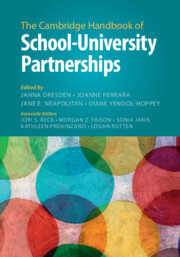Book contents
- The Cambridge Handbook of School–University Partnerships
- The Cambridge Handbook of School–University Partnerships
- Copyright page
- Contents
- Figures
- Tables
- Contributors
- Foreword
- Preface
- Acknowledgments
- Part I The History and Conceptual Foundations of School–University Partnerships
- Introduction to Part I: The History and Conceptual Foundations of School–University Partnerships
- 1 Origins
- 2 The Legacy of John I. Goodlad (1920–2014)
- 3 More Commonalities Than Differences
- 4 From Holmes to Here
- 5 Theorizing Partnership Work
- 6 The Metaphors We Partner By
- 7 Commentary: Focus versus Locus
- 8 Commentary: From Mission to Metaphors and Questions in Between
- 9 Commentary: Historical Perspectives and Conceptual Foundations of School–University Partnerships
- Part II Teachers and Learning to Teach in School–University Partnerships
- Part III Equity and Student Learning in School–University Partnerships
- Part IV Leadership in School–University Partnerships
- Part V Community Schools as School–University Partnerships
- Part VI Inquiry and Innovation in School–University Partnerships
- Part VII Funding, Policy, and the Politics of School–University Partnerships
- Part VIII Looking at School–University Partnerships across Geographic and Cultural Borders
- Index
8 - Commentary: From Mission to Metaphors and Questions in Between
from Part I - The History and Conceptual Foundations of School–University Partnerships
Published online by Cambridge University Press: 05 November 2025
- The Cambridge Handbook of School–University Partnerships
- The Cambridge Handbook of School–University Partnerships
- Copyright page
- Contents
- Figures
- Tables
- Contributors
- Foreword
- Preface
- Acknowledgments
- Part I The History and Conceptual Foundations of School–University Partnerships
- Introduction to Part I: The History and Conceptual Foundations of School–University Partnerships
- 1 Origins
- 2 The Legacy of John I. Goodlad (1920–2014)
- 3 More Commonalities Than Differences
- 4 From Holmes to Here
- 5 Theorizing Partnership Work
- 6 The Metaphors We Partner By
- 7 Commentary: Focus versus Locus
- 8 Commentary: From Mission to Metaphors and Questions in Between
- 9 Commentary: Historical Perspectives and Conceptual Foundations of School–University Partnerships
- Part II Teachers and Learning to Teach in School–University Partnerships
- Part III Equity and Student Learning in School–University Partnerships
- Part IV Leadership in School–University Partnerships
- Part V Community Schools as School–University Partnerships
- Part VI Inquiry and Innovation in School–University Partnerships
- Part VII Funding, Policy, and the Politics of School–University Partnerships
- Part VIII Looking at School–University Partnerships across Geographic and Cultural Borders
- Index
Summary
This chapter explores the transformative potential of pre-service teachers (PSTs) partnering with community activist organizations (CAOs) as part of their teacher preparation program. Through summer internships with CAOs, PSTs gain insights into community cultural wealth, systemic oppression, and issues facing marginalized communities. This engagement enables PSTs to develop a racial and social justice lens and understand their future students’ strengths and challenges. The chapter presents how these experiences inform curriculum development, leading to community-responsive pedagogy. It highlights enduring understandings PSTs gain from CAO partnerships, emphasizing the wisdom of local communities, collective action, diverse forms of activism, the joy of community engagement, and integration of community issues in curriculum. Policymakers are encouraged to support such partnerships to equip educators for socially just teaching. Further research is suggested to explore long-term impacts and best practices in CAO engagement.
Keywords
Information
- Type
- Chapter
- Information
- The Cambridge Handbook of School–University Partnerships , pp. 133 - 136Publisher: Cambridge University PressPrint publication year: 2025
Accessibility standard: WCAG 2.1 AA
Why this information is here
This section outlines the accessibility features of this content - including support for screen readers, full keyboard navigation and high-contrast display options. This may not be relevant for you.Accessibility Information
Content Navigation
Allows you to navigate directly to chapters, sections, or non‐text items through a linked table of contents, reducing the need for extensive scrolling.
Provides an interactive index, letting you go straight to where a term or subject appears in the text without manual searching.
Reading Order & Textual Equivalents
You will encounter all content (including footnotes, captions, etc.) in a clear, sequential flow, making it easier to follow with assistive tools like screen readers.
Visual Accessibility
You will still understand key ideas or prompts without relying solely on colour, which is especially helpful if you have colour vision deficiencies.
Structural and Technical Features
You gain clarity from ARIA (Accessible Rich Internet Applications) roles and attributes, as they help assistive technologies interpret how each part of the content functions.
